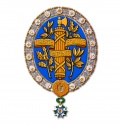Duchy of Bar: Difference between revisions
Knorrepoes (talk | contribs) |
Knorrepoes (talk | contribs) m (Text replacement - " Wapen- en Vlaggenboek van Gerrit Hesman (1708)" to " Wapen- en Vlaggenboek van Gerrit Hesman (1708)") |
||
| Line 15: | Line 15: | ||
{|align="center" | {|align="center" | ||
|align="center"|[[File:{{PAGENAME}}.hes.jpg|350 px|center|Arms of {{PAGENAME}}]]<br/>The arms in the Wapen- en Vlaggenboek van Gerrit Hesman (1708) | |align="center"|[[File:{{PAGENAME}}.hes.jpg|350 px|center|Arms of {{PAGENAME}}]]<br/>The arms in the [[Wapen- en Vlaggenboek Hesman|Wapen- en Vlaggenboek]] van Gerrit Hesman (1708) | ||
|} | |} | ||
Revision as of 12:55, 9 January 2022
French heraldry portal
This page is part of the French heraldry portal |
Heraldry of the World |
|
French heraldry:
Overseas territories:
|
Selected collector's items from France:
|
DUCHY OF BAR
Official blazon
Origin/meaning
The Duchy of Bar was a principality of the Holy Roman Empire encompassing the pays de Barrois and centred on the city of Bar-le-Duc. It was held by the House of Montbéliard from the 11th century. Part of the county, the so-called Barrois mouvant, became a fief of the Kingdom of France in 1301 and was elevated to the Duchy of Bar in 1354. The Barrois non-mouvant remained a part of the Empire. From 1480, it was united to the imperial Duchy of Lorraine.
Both imperial Bar and Lorraine came under the influence of France in 1735, with Bar ceded to the deposed king of Poland, Stanisław Leszczyński. According to the Treaty of Vienna (1738), the duchy would pass to the French crown upon Stanisław's death, which occurred in 1766.
The arms show a field semy of crosses and two canting barbels. Different variations of the arms exist, as shown in the image above from 1530.
The arms in the Wapen- en Vlaggenboek van Gerrit Hesman (1708) |
Contact and Support
Partners:
Your logo here ?
Contact us
© since 1995, Heraldry of the World, Ralf Hartemink 
Index of the site
Literature : Historical background from Wikipedia













